sequoyah101
Silver Member
- Joined
- Nov 13, 2009
- Messages
- 159
- Location
- East Central Oklahoma
- Tractor
- CaseIH 50A, CaseIH JX95, CaseIH JX80, Allis 190XT, Daewoo DD80L Dozer, Schaeff SKL831 Loader, Komatsu PC40-7 Trackhoe, JCB 210S TLB, JD750, JD820, Kubota FR3680, Kioti Mechron
I don't post much and only when I think it is something I wish I had known and have something that I would have thought useful to have learned.
If you are really interested in this you can go to the maker's web sites and get the manuals and more pictures.
I just finished the first job with the Modern Ag Products Path Slayer. The task was pushing back many years of fence line growth here in our temperate hardwood forest. With 50 or more inches of rain a year it does not take long for the undergrowth and Eastern Red Cedar to make a lot of progress. At least I can now see the back fence I bought some years ago. I've attached a picture of what I cut, grappled and stacked over a period of under 30 hours of work. The machine did work but with some misgivings.
I'll add before getting to the discussion of the various machines of this type that are offered that these small brush cutters that go vertical to trim back brush are offered and shown to be used on small tractors of more than about 3500 lbs. I tried this on my new Farmall 50A that is a heavy tractor and I was not comfortable. 550 lbs or so hanging out on the side of the loader is tippy and tough duty even with four rear wheel weights like I have. It might work for light brush or clipping hedges or something but not for the work I've done. You also need to keep the engine RPM up to keep the cutter blades spinning fast enough to have enough momentum to power through stuff without squealing the bypass too often and you also need to have exceptionally low speeds in low gear or a hydrostatic transmission. The little loader I ended up using this on is the only thing on the place that is hydrostatic I could hook the cutter to. At 13,000 lbs it is also plenty heavy for this brush cutter but even it feels a bit tippy when the thing is boomed all the way up and bumps a big limb.
This is my second Path Slayer from Modern. The first version of this did not make it more than about 100 yards from the gate before it literally unfolded and fell apart. If I had it to do over I would now buy the new TB-Max for about $500 more.
First suffer a little background. I know of three makers of this type of machine with Lane Shark being the first, Trail Blazer being another and Modern Ag being the third. I really wanted the TB-one considering it to be much better made than any available but let me show why I ended up with the Modern product.
Lane Shark: This is built much like the Path Slayer by Modern but I refuse to buy one first on what I consider to be less than adequate construction / design and second on principals. Trail Blazer was a better product and Lane Shark apparently sued them for patent infringement. Rather than fight, Trail Blazer withdrew their product.
TB-One: This is what I really wanted but last summer when I made my purchase they had apparently succumbed to a patent infringement suit by Lane Shark and ended production of their superior design and construction using an honest to goodness bearing in the swing arm instead of just a sloppy big bolt in a hole like Lane Shark used and then Modern did the same. What they did instead is to make a machine with a permanent offset. Not at all a suitable design to me. I see now that they have since made a machine that uses two bearings on the swing mechanism and for about $500 more than the competition it looks to be quite a good machine with necessary beef in the right places, what looks like very good fit and finish and some decent engineering. I wish I had one instead of the Modern Path Slayer I now have. The new design makes me a little put out. Anybody want to buy a working slightly used but broken in Path Slayer for half-price?
Continuing.
Path Slayer: Modern is on their third version of this machine. The first one was one I bought first this summer. The one that fell apart in transport to work. I wonder if they even tried to use it in anger or just penciled something out for the fab shop and threw it together. No need to delve into this first version, it was junk. Second version, the one I now have made some cobbled up modifications to remedy the untested junk prototype that should have never been marketed. The second one does not fall apart but you have to be careful, in fact baby it, so it is not much better than the first version. I will go into the pros and cons of this machine presently. The third version may not be too bad. Not sure it has much more than the big bolt and hole for the pivot point but they did make some small improvements such as bushed pin holes in some places. It still has the Achilles Heel problem of not recognizing that a large force on a lever arm many times longer than the short lever arm where the resistive pin is located translates to a HUUUUGE force on the pin. I don't think the good 'ole boys down in Beaumont do a whole lot of engineering on things but they can weld and hot dip galvanize. Maybe now that the business for Frac pumps and tanks has gone to heck they can put a little more focus on implements.
The Path Slayer will need some substantial and time consuming modifications to make it durable and more useful. Nothing is ever simple. I thought I could make some field improvements by just using 7/8" pins that would fit the holes well instead of the 1/2" pins supplied. Well, you can't, since the holes are a mix of 13/16" and just proud of 7/8" holes. The fab shop must have one crew drilling big holes in the mounting plate and another crew drilling small holes in the swing arm and yet a third crew putting scrawny 1/2" pins in the final assembly. At least the welding is good and the holes are actually round.
You know, the more I write the more I am inclined to just go buy a TB-Max and chalk my $3,500 up to bad experience.
The good about the Path Slayer:
1. The deck is bullet proof and galvanized instead of painted. They do a good job on this part.
2. The motor is commercial used for cement mixers and garbage trucks and such. It also drives through a gear box so the load is not directly on the motor shaft.
3. It has a decent priority valve and bypass that seems to work well and protects the motor from flow over the rated 10 gpm
4. There is a stump jumper instead of a bar carrier. This is all but essential for whacking tree limbs and cutting on the ground. My blades need replaced already they have taken such a beating. I don't think they are very good blades though since they chipped instead of dented like good ones do and there is some kind of strange erosion I have never seen on mower blades.
5. So long as you keep the thing wound up it will actually cut nearly 4" stuff. I was able to cut the whole side out of some fairly large cedar trees. What I could not cut off with the Path Slayer I lopped the top out of with the tree shear. It is a Quick Attach and a great piece of equipment by the way. The branches are numerous but brittle and just nasty to mess with. Six things I hate: Eastern Red Cedar, gophers, yaupon holly, wild ligustrum, snakes and fire ants. This is not a complete list but I'll leave it at that now and not get into politics or social engineering.
The bad and there is a lot of it:
1. I can't forgive Modern for marketing a unit so badly put together as my first unit. The second one is not much better.
2. The skid steer plate was cut wrong so I had to cut the bottom pin holes large enough to fit on the tractor using a gas axe on my brand new implement and then do a little reinforcing welding. That pissed me off. it was just built wrong not even meeting the SAE specifications that are easy enough to read and use and check; so they shipped a unit that was just wrong to begin with.
3. The main pivot is sloppy and makes the unit droop and flop around. I just hope it does not get worse. A bolt and hole just don't cut it to cantilever 500 lbs on a moving machine.
4. The finger they added to hold the deck in place while stowed is flimsy, just a Rube Goldberg band aid fix. I've already heated it once to bend it back in palce and will have to beef the thing up with a set of gussets to keep it in place.
5. The pins that hold the swing arm in the various positions are not nearly big enough for the loads imposed. One has already bent. I'll have to make the pins bigger but first I'll have to make all the holes the same size. You just can't put a 500 lb force on the end of a 36" lever arm and hold it in place with a 3" lever arm on the other side of the fulcrum. Just won't work. Not with sloppy pin holes and small pins. That 500 lbs becomes 12 x 500 lbs force on the dinky little 1/2" pin. Easy math and physics.
6. Holes that hold the pins are not the same size. Not only will I have to bore them out but they also need bushings. You can't stick a pin through a hole in a plate that has moment on it. The intended load is shear and not moment. This means that I will have to buy some mechanical tube the right size, enlarge the holes in the plates and then weld the mechanical tube in place probably with some small gussets to keep the whole affair in as close to shear as I can make it while still having enough slop in the pin hole tolerances to allow for the floppy main pivot.
7. A minor but irritating thing is they made a nice plate to put the quick attach hydraulic fittings on but didn't bother to use bulkhead fittings to secure the quick attach couplers so that is another thing I'll have to spend time and money making right.
8. I really need to change the retaining pin holes location and extend the short lever arm and probably have to clamp the support arm to the backing plate using a big wing nut or something similar to keep the whole thing stout. I think the 36" support arm and 3" restraining or retaining arm are a losing battle no matter how much mechanical tube and well fitting pins one uses.
9. I'll probably also make some kind of strut to support the deck while in the horizontal position to keep the thing from bouncing up and down.
So there you have it, my review of the Path Slayer after cutting 1/2 mile of cedar limbs and other assorted brush.
I sure do wish Trail Blazer had made the Max just a little sooner and I'd have one of those instead of having so much work to do to make the Path Slayer work for me. It adds insult to injury to have to make such major modifications. Just sorry to see someone make such a piece of junk and offer it for sale. I wouldn't do such a dishonest thing.
I thought I knew how to post photos but maybe I don't.
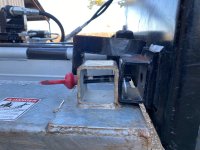
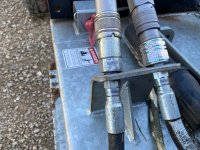
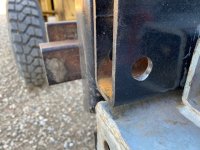
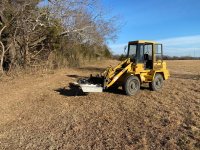
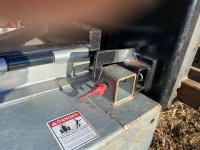
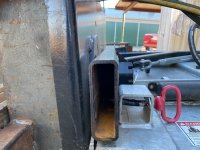
If you are really interested in this you can go to the maker's web sites and get the manuals and more pictures.
I just finished the first job with the Modern Ag Products Path Slayer. The task was pushing back many years of fence line growth here in our temperate hardwood forest. With 50 or more inches of rain a year it does not take long for the undergrowth and Eastern Red Cedar to make a lot of progress. At least I can now see the back fence I bought some years ago. I've attached a picture of what I cut, grappled and stacked over a period of under 30 hours of work. The machine did work but with some misgivings.
I'll add before getting to the discussion of the various machines of this type that are offered that these small brush cutters that go vertical to trim back brush are offered and shown to be used on small tractors of more than about 3500 lbs. I tried this on my new Farmall 50A that is a heavy tractor and I was not comfortable. 550 lbs or so hanging out on the side of the loader is tippy and tough duty even with four rear wheel weights like I have. It might work for light brush or clipping hedges or something but not for the work I've done. You also need to keep the engine RPM up to keep the cutter blades spinning fast enough to have enough momentum to power through stuff without squealing the bypass too often and you also need to have exceptionally low speeds in low gear or a hydrostatic transmission. The little loader I ended up using this on is the only thing on the place that is hydrostatic I could hook the cutter to. At 13,000 lbs it is also plenty heavy for this brush cutter but even it feels a bit tippy when the thing is boomed all the way up and bumps a big limb.
This is my second Path Slayer from Modern. The first version of this did not make it more than about 100 yards from the gate before it literally unfolded and fell apart. If I had it to do over I would now buy the new TB-Max for about $500 more.
First suffer a little background. I know of three makers of this type of machine with Lane Shark being the first, Trail Blazer being another and Modern Ag being the third. I really wanted the TB-one considering it to be much better made than any available but let me show why I ended up with the Modern product.
Lane Shark: This is built much like the Path Slayer by Modern but I refuse to buy one first on what I consider to be less than adequate construction / design and second on principals. Trail Blazer was a better product and Lane Shark apparently sued them for patent infringement. Rather than fight, Trail Blazer withdrew their product.
TB-One: This is what I really wanted but last summer when I made my purchase they had apparently succumbed to a patent infringement suit by Lane Shark and ended production of their superior design and construction using an honest to goodness bearing in the swing arm instead of just a sloppy big bolt in a hole like Lane Shark used and then Modern did the same. What they did instead is to make a machine with a permanent offset. Not at all a suitable design to me. I see now that they have since made a machine that uses two bearings on the swing mechanism and for about $500 more than the competition it looks to be quite a good machine with necessary beef in the right places, what looks like very good fit and finish and some decent engineering. I wish I had one instead of the Modern Path Slayer I now have. The new design makes me a little put out. Anybody want to buy a working slightly used but broken in Path Slayer for half-price?
Continuing.
Path Slayer: Modern is on their third version of this machine. The first one was one I bought first this summer. The one that fell apart in transport to work. I wonder if they even tried to use it in anger or just penciled something out for the fab shop and threw it together. No need to delve into this first version, it was junk. Second version, the one I now have made some cobbled up modifications to remedy the untested junk prototype that should have never been marketed. The second one does not fall apart but you have to be careful, in fact baby it, so it is not much better than the first version. I will go into the pros and cons of this machine presently. The third version may not be too bad. Not sure it has much more than the big bolt and hole for the pivot point but they did make some small improvements such as bushed pin holes in some places. It still has the Achilles Heel problem of not recognizing that a large force on a lever arm many times longer than the short lever arm where the resistive pin is located translates to a HUUUUGE force on the pin. I don't think the good 'ole boys down in Beaumont do a whole lot of engineering on things but they can weld and hot dip galvanize. Maybe now that the business for Frac pumps and tanks has gone to heck they can put a little more focus on implements.
The Path Slayer will need some substantial and time consuming modifications to make it durable and more useful. Nothing is ever simple. I thought I could make some field improvements by just using 7/8" pins that would fit the holes well instead of the 1/2" pins supplied. Well, you can't, since the holes are a mix of 13/16" and just proud of 7/8" holes. The fab shop must have one crew drilling big holes in the mounting plate and another crew drilling small holes in the swing arm and yet a third crew putting scrawny 1/2" pins in the final assembly. At least the welding is good and the holes are actually round.
You know, the more I write the more I am inclined to just go buy a TB-Max and chalk my $3,500 up to bad experience.
The good about the Path Slayer:
1. The deck is bullet proof and galvanized instead of painted. They do a good job on this part.
2. The motor is commercial used for cement mixers and garbage trucks and such. It also drives through a gear box so the load is not directly on the motor shaft.
3. It has a decent priority valve and bypass that seems to work well and protects the motor from flow over the rated 10 gpm
4. There is a stump jumper instead of a bar carrier. This is all but essential for whacking tree limbs and cutting on the ground. My blades need replaced already they have taken such a beating. I don't think they are very good blades though since they chipped instead of dented like good ones do and there is some kind of strange erosion I have never seen on mower blades.
5. So long as you keep the thing wound up it will actually cut nearly 4" stuff. I was able to cut the whole side out of some fairly large cedar trees. What I could not cut off with the Path Slayer I lopped the top out of with the tree shear. It is a Quick Attach and a great piece of equipment by the way. The branches are numerous but brittle and just nasty to mess with. Six things I hate: Eastern Red Cedar, gophers, yaupon holly, wild ligustrum, snakes and fire ants. This is not a complete list but I'll leave it at that now and not get into politics or social engineering.
The bad and there is a lot of it:
1. I can't forgive Modern for marketing a unit so badly put together as my first unit. The second one is not much better.
2. The skid steer plate was cut wrong so I had to cut the bottom pin holes large enough to fit on the tractor using a gas axe on my brand new implement and then do a little reinforcing welding. That pissed me off. it was just built wrong not even meeting the SAE specifications that are easy enough to read and use and check; so they shipped a unit that was just wrong to begin with.
3. The main pivot is sloppy and makes the unit droop and flop around. I just hope it does not get worse. A bolt and hole just don't cut it to cantilever 500 lbs on a moving machine.
4. The finger they added to hold the deck in place while stowed is flimsy, just a Rube Goldberg band aid fix. I've already heated it once to bend it back in palce and will have to beef the thing up with a set of gussets to keep it in place.
5. The pins that hold the swing arm in the various positions are not nearly big enough for the loads imposed. One has already bent. I'll have to make the pins bigger but first I'll have to make all the holes the same size. You just can't put a 500 lb force on the end of a 36" lever arm and hold it in place with a 3" lever arm on the other side of the fulcrum. Just won't work. Not with sloppy pin holes and small pins. That 500 lbs becomes 12 x 500 lbs force on the dinky little 1/2" pin. Easy math and physics.
6. Holes that hold the pins are not the same size. Not only will I have to bore them out but they also need bushings. You can't stick a pin through a hole in a plate that has moment on it. The intended load is shear and not moment. This means that I will have to buy some mechanical tube the right size, enlarge the holes in the plates and then weld the mechanical tube in place probably with some small gussets to keep the whole affair in as close to shear as I can make it while still having enough slop in the pin hole tolerances to allow for the floppy main pivot.
7. A minor but irritating thing is they made a nice plate to put the quick attach hydraulic fittings on but didn't bother to use bulkhead fittings to secure the quick attach couplers so that is another thing I'll have to spend time and money making right.
8. I really need to change the retaining pin holes location and extend the short lever arm and probably have to clamp the support arm to the backing plate using a big wing nut or something similar to keep the whole thing stout. I think the 36" support arm and 3" restraining or retaining arm are a losing battle no matter how much mechanical tube and well fitting pins one uses.
9. I'll probably also make some kind of strut to support the deck while in the horizontal position to keep the thing from bouncing up and down.
So there you have it, my review of the Path Slayer after cutting 1/2 mile of cedar limbs and other assorted brush.
I sure do wish Trail Blazer had made the Max just a little sooner and I'd have one of those instead of having so much work to do to make the Path Slayer work for me. It adds insult to injury to have to make such major modifications. Just sorry to see someone make such a piece of junk and offer it for sale. I wouldn't do such a dishonest thing.
I thought I knew how to post photos but maybe I don't.







